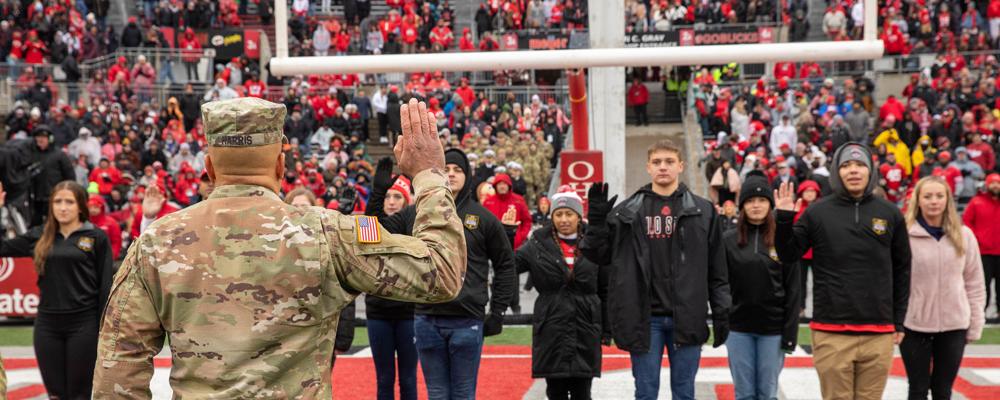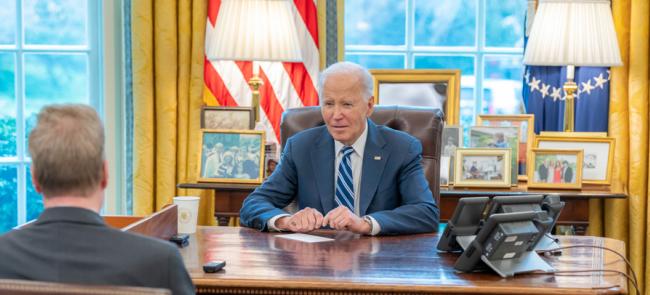
Hopeful Signs
It seems that 2022 may not have been such a bad growing year after all, based on some numbers from the autumn harvest. Or could it have been, sticking with the agricultural metaphor, an unexpectedly good second crop?
For one reason or several, “for the first quarter of fiscal year 2023 — October, November and December — National Guard recruiting continued in a positive direction,” the National Guard Bureau reported Feb. 6. “Specifically, Air National Guard accessions increased by 11% compared to the first quarter of FY 2022.”
And it gets better: “Army Guard enlistments also increased in the first quarter. In January, a 43% increase occurred, which increased ARNG enlistments by 7% fiscal year to date.”
“We anticipate this trend to continue throughout the year due to the efforts of the recruiting force and the success of current recruiting initiatives,” NGB spokesman Kurt Rauschenberg further explained.
Rauschenberg said seven states — Alabama, Idaho, Minnesota, Nevada, New Jersey, New York and Wyoming — were exceeding recruitment expectations for the Army Guard, while three states — Arkansas, Arizona and Mississippi — led the way for the Air Guard.
This is music to Guard leaders’ ears. Last year, both the Army and Air Guard missed their recruiting goals as every service, especially the active-component Army, struggled to find new members.
But the latest numbers defy recent recruiting assessments by Army and Air Force leaders. Army Secretary Christine Wormuth calls this “the most challenging recruiting landscape in decades.” Air Force Secretary Frank Kendall said his service will also likely miss its goals this year.
They point to low unemployment and a shrinking pool of potential recruits due to basic health, behavioral and education standards. Today, only 23% of young people age 18 to 24 are eligible to join.
Other restrictions reduce that figure even further. Tattoos, for example. Young people today have more ink in more places than previous generations. Consequently, the Department of the Air Force relaxed its tattoo policy March 1 to allow airmen and guardians to now have a single small tattoo on each hand and one on their neck.
COVID-19 also hurt. And not just concern among some about the vaccine mandate. Armed Service Vocational Aptitude Battery tests scores are down 9% nationwide since the start of the pandemic, and more than one teenager in five is obese. Experts link both figures to pandemic constraints.
The same restrictions prevented recruiters from presenting opportunities in the military to potential enlistees in schools for more than a year. Recruiters can now get back in some schools, but the toll of that lack of access lingers.
Another reason, say some, is a declining propensity to serve. Recent Army surveys say young people don’t see the service as a safe place or a good career, and believe they would have to put their lives and careers on hold if they enlisted.
Guard service can be more accommodating, but Lt. Col. Richard Stackpole, the commander of the Tennessee Army Guard’s Recruiting and Retention Battalion, says he sees much of what the Army surveys found.
“The environment during the last 20 years has changed significantly,” he says. “This generation is a lot more entrepreneurial. They want to be their own boss. They don’t necessarily want to be told what to do.”
Furthermore, Stackpole points out that while “a lot of the young men and women [of military age] weren’t even alive on 9/11,” they’ve seen stories about troops returning home from Iraq and Afghanistan with PTSD and other wounds.
“This generation grew up on that,” he says. “High-school age kids are discussing PTSD as a serious concern. It’s left a mark, and this generation is weighing that into their decision of whether or not to serve.”
By early February, however, it seemed as if things were looking up, but it was too early to tell if the positive Guard figures were trend or a temporary blip.
Recruiting's hard, but it's nothing we can't overcome and improve.
—Lt. Col. Richard Stackpole, the commander of the Tennessee Army Guard’s Recruiting and Retention Battalion
SOME OFFICIALS SAY a new sense of urgency and cross-component and cross-state cooperation are helping.
“There’s a collaborative environment where not only the Army Guard, the Air Guard, the Air Force, the Army, we’re all working together to help each other to get through this problem of recruiting,” says Col. Anthony Pasquale, the chief of the Air Guard’s Recruiting and Retention Division.
Many states are pulling out all the stops, going to extra lengths to elevate the Guard’s presence in the community.
The concert band for New York’s 42nd Infantry Division got into the act, even though the Empire State did meet its goal, by performing holiday programs in communities across the state.
“The band is a very forward-facing unit,” said Staff Sgt. Pamela Pfiel, a flutist, told the American Homefront Project. “We kind of look at ourselves as musical ambassadors to our communities, and we bridge the gap between the military and our civilian population.”
“There’s not one way of doing business,” says Lt. Col. Josh Heimroth, the commander of the New York Army Guard’s Recruiting and Retention Battalion. “You’ve got to have multiple lines in the pond to catch the fish.”
Some of those lines look more like big nets. Several states are trying to augment their traditional recruiting corps with state-funded bonus programs that pay non-recruiters who provide the names of people who end up enlisting in Guard.
Programs in Alabama, Delaware, Indiana, Michigan, North Dakota, Vermont and Virginia have similarities to the Guard Recruiting Assistant Program that NGB ran from 2005 through 2012 that brought in 130,000 recruits to the Army Guard alone.
In Indiana, the Referral Enlistment Program is open to any citizen over 18 years of age who’s not an Indiana Guard recruiter or shares a household with one. They just need to sign up to be Personnel Development Coordinator.
PDCs receive $1,000 when a referral signs an enlistment contract and passes a drug test, says Maj. Jay Hildebrand, the operations officer for the Indiana Army Guard Recruiting and Retention Battalion.
The program began in November, and is set to run through the end of July. By late January, he says, 101 PDCs had provided 154, including 106 for the Army Guard, 22 for the Air Guard and 17 “who were interested in either one.” Twenty-three referrals had enlisted.
“We don’t really have a goal type for this program. It’s just an enabler,” he adds. “The PDCs are certainly enhancing the recruiting force. I think it’s a lot of our newer, younger soldiers getting involved. They still have friends in high school or friends who have recently graduated. That’s a target audience.”
The programs vary from state to state. The Virginia Guard’s Referral Enlistment Program, for example, pays up to $750 and is open to any Virginian. But the Vermont Guard’s Joint Enlistment Enhancement Program only seeks referrals from Vermont Guardsmen, federal civilian employees of the Guard and retirees.
Officials ended G-RAP abruptly in 2015 after the Army alleged $100 million in fraud in the program. Service investigators did find some fraud, but far than less than was suspected. Still, NGB was faulted for failing to provide adequate oversight.
Those overseeing the state referral programs have apparently taken those lessons to heart.
“This is a state program. It’s a little more controlled by us as far as checks and balances,” says Hildebrand in Indiana. “I think the lesson from G-RAP is that there was potential for fraud in that program. It definitely made us cautious as far as this program, which is why we have four or five people at each stage of the process verify that everything is correct.”

A NEW ARMY PROGRAM is helping young people who do want to serve in the Army Guard but don’t immediately meet service weight standards or score high enough on the ASVAB.
Service officials established the Future Soldier Preparatory Course pilot at Fort Jackson, South Carolina, in August. There are two tracks: one is academic and the other fitness. Potential recruits can participate in one or the other. They have 90 days to meet accession standards.
The academic component, called Task Force Opportunity, is for a small percentage of recruits who have enlisted with ASVAB scores between 21 and 30 points, out of a possible 99, intent on taking the entrance test again.
They are Category IV recruits with a temporary military occupational specialty 09M. They must improve their scores to rise out of Cat IV or risk discharge. Those who improve may renegotiate their initial contract, perhaps for a better job, and go to basic training.
Instructors focus on vocabulary, reading comprehension, arithmetic reasoning and test-taking skills to improve their chances.
The fitness component resembles the basic training routines of running and pushups intended to harden civilians into soldiers. Trainers and dieticians coach recruits to safely lose 1-2% of body fat each month by adhering to the Army’s Health and Holistic Fitness standards.
The results have been impressive for hundreds of Guard recruits attending the course, says South Carolina Col. Byron Williams, the Guard’s chief of staff at Jackson.
More than 700 enlisted in the 09M academic program from every state and territory by late January. More than 500 tested, and over 480 passed. More than 470 have gone on to basic combat training.
The course works so well because participants are put into a new environment where they are able to concentrate and learn, Williams says.
“There are no distractions whatsoever,” he explains. “It really gives these young people an opportunity to really focus, likely like they’ve never been able to focus before on their academics; an opportunity to eat properly, to exercise properly and really focus on the holistic approach to their fitness.”
“In the civilian world, leaning how to eat clean was a big challenge,” recruit Jonathan Jeffers said in December. “Like, Hey, I need to eat healthier, but that sometimes comes with a higher cost and takes some effort. It’s easier to get [healthy alternatives] here. Everything’s laid out for you.”
Furthermore, the course introduces recruits to the regimentation and discipline of military life.
“I call it an acclimation period,” Williams adds. “It’s an opportunity for them to become acclimated to the military before having the true stressors, basic combat training.”
Overall, the course has exceeded Army expectations. By the end of December, 2,965 of the course’s 3,206 attendees — nearly 93% — had successfully met entry standards and proceeded to basic training, according to an Army release.
As a result, the Army is expanding the program, with two additional academic programs at Jackson and a company-sized version at Fort Benning, Georgia.
“Recruiting’s hard,” says Stackpole, while working the front line in Tennessee. “But it’s nothing we can’t overcome and improve.”
“Sometimes that just means looking at the entire recruiting pipeline holistically and finding out where we can find programs like this that can benefit those citizens who do want to raise their right hand and serve.”
Bob Haskell is a retired Maine Army National Guard master sergeant and a freelance journalist in Falmouth, Mass. He may be contacted via magazine@ngaus.org.
EDUCATION IS STILL NO. 1 ATTRACTION
Incentives to join the National Guard are pretty impressive.
A Non-Prior Service Enlistment Bonus of $20,000 is available to Army Guard recruits who select specific military occupational specialties, NGB reports. Each state, territory or district can designate seven MOSs.
A $20,000 bonus is also available for prior-service soldiers who are MOS qualified.
Education benefits remain appealing even though it’s been pointed out that civilian companies are also enriching that incentive to attract employees.
“The Joint Advertising Marketing and Research Survey continues to say that education is the No. 1 reason that our applicants join the Army National Guard,” says Kenneth Hardy, the chief of education services for the Army Guard at NGB.
Forty-three states are now offering 100% paid tuition to state colleges and universities to their Guardsmen compared to fewer than 20 states a decade ago, he says. South Dakota is the most recent addition.
A credentialing assistance program now pays for soldiers to obtain a credential or license, as plumbers and electricians for example, in as many as 1,600 fields that are related to an Army MOS.
Soldiers are now also eligible to use tuition assistance immediately after they are sworn in rather than having to wait for a year.
— By Bob Haskell



